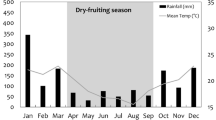Summary
Members of competing species may influence their share of food sources either by finding new feeding sites more frequently or by more effectively monopolizing those sites once found. We describe a model that separates the effects of these two forms of competition; in a set of African forest primates, only the first has a major effect on species' relative population densities. The model identifies factors which might lead to a greater role of interference at food sources in other communities.
Similar content being viewed by others
References
Aitken AC (1937) Studies in practical mathematics: the evaluation of the latent roots and latent vectors of a matrix. Proc Roy Soc Edinburgh 57:269–304
Bellman R (1970) Introduction to Matrix Analysis. McGraw-Hill, New York
Chivers DT (1973) An introduction to the socioecology of some Malayan forest primates. In: RP Michael and JH Crook (eds), Comparative Ecology and Behaviour of Primates. Academic Press, New York, pp 101–146
Clutton-Brock TH (1975) Ranging behaviour of red colobus (Colobus badius tephrosceles) in the Gombe National Park. An Beh 23:706–722
Connell JH (1975) Some mechanisms producing structure in natural communities: a model and evidence from field experiments. In: ML Cody and JM Diamond (eds), Ecology and Evolution of Communities, Belknap Press, Cambridge, pp 460–490
Eisenberg JF, Muckenhirn NA, Rudran R (1972) The relation between ecology and social structure in primates. Science 176:863–874
Gartlan JS, Struhsaker TT (1972) Polyspecific associations and niche separation of rain-forest anthropoids in Cameroon, West Africa. J Zool Lond 168:221–266
Gautier JP, Gautier-Hion A (1969) Les associations polyspecifiques chez les Cercopithecidae du Gabon. Terre et Vie 2:164–201
Horn HS (1975) Markovian processes of forest succession. In: ML Cody and JM Diamond (eds), Ecology and Evolution of Communities. Belknap Press, Cambridge Mass, pp 196–213
Horn H, MacArthur R (1972) Competition among fugitive species in a harlequin environment. Ecology 53:749–752
Hutchinson GE (1951) Copepodology for the ornithologist. Ecology 32:571–577
Hutchinson GE (1959) Homage to Santa Rosalia or, why are there so many kinds of animals? Am Nat 43:145–159
Miller RS (1967) Pattern and process in competition. Adv Ecol Res 4:1–74
Paine RT (1977) Controlled manipulations in the marine intertidal zone and their contributions to ecological theory. Philadelphia Acad Nat Sci Special Publ 12:245–270
Rudran R (1976) Unpublished PhD Thesis, University of Maryland
Rudran R (1978a) Socioecology of the blue monkey (Cercopithecus mitis stuhlmanni) of the Kibale Forest, Uganda. Smiths Contr Zool 249
Rudran R (1978b) Foraging ecology of blue monkeys (Cercopithecus mitis stuhlmanni). In: GG Montgomery (ed), Ecology of Arboreal Folivores. Smithsonian University Press, Washington
Struhsaker TT (1969) Correlates of ecology and social organization among African cercopithecines. Folia primat 11:80–118
Struhsaker TT (1975) The Red Colobus Monkey. University of Chicago Press, Chicago.
Struhsaker TT (1978) Food habits of five monkey species in the Kibale Forest, Uganda. In: D Chivers and J Herbert (eds), Recent Advances in Primatology, Academic Press, New York 1:225–248
Struhsaker TT (1978b) Interrelations of red colobus monkeys and rain-forest trees in the Kibale Forest, Uganda. In: GG Montgomery (ed), The Ecology of Arboreal Folivores. Smithsonian Institution Press, Washington, DC, pp 397–422
Struhsaker TT (1980) Comparison of the behavior and ecology of red colobus and redtail monkeys in the Kibale Forest, Uganda Afr J Ecol 18:33–52
Struhsaker TT, Leland L (1979) Socioecology of five sympatric monkey species in the Kibale Forest, Uganda Adv Stud Beh 9:159–228
Waser P (1975) Monthly variations in feeding and activity patterns of the mangabey, Cercocebus albigena. E Afr Wildl J 13:249–263
Waser PM (1976) Cercocebus albigena: site attachment, avoidance, and intergroup spacing. Am Nat 110:911–935
Waser PM (1977b) Feeding, ranging, and group size in the mangabey Cercocebus albigena. In: T Clutton-Brock (ed), Primate Ecology. Academic Press, New York, pp 183–222
Waser PM (1980) Polyspecific associations of Cercocebus albigena: geographic variation and ecological correlates. Folia primatol 33:57–76
Wrangham R (1977) Feeding behavior of chimpanzees in Gombe National Park, Tanzania. In: T Clutton-Brock (ed), Primate Ecology. Academic Press, New York, pp 504–538
Author information
Authors and Affiliations
Rights and permissions
About this article
Cite this article
Waser, P.M., Case, T.J. Monkeys and matrices: On the coexistence of “omnivorous” forest primates. Oecologia 49, 102–108 (1981). https://doi.org/10.1007/BF00376906
Received:
Issue Date:
DOI: https://doi.org/10.1007/BF00376906




